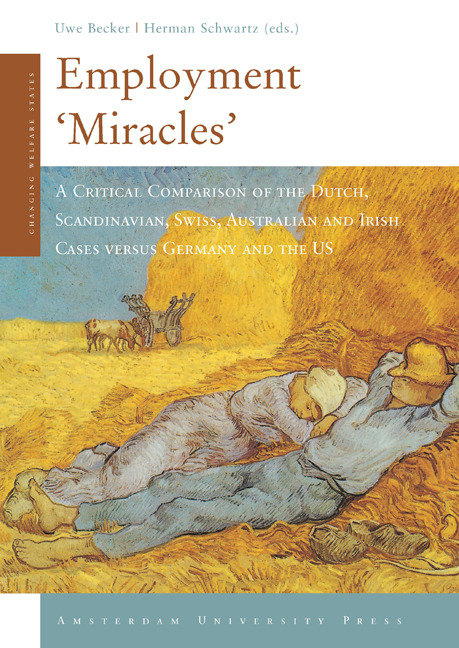 Employment 'Miracles'
Employment 'Miracles' Book contents
- Forntmatter
- Contents
- Preface
- 1 Introduction: Miracles, Mirages and Markets
- 2 The Dutch Model: Magic in a Flat Landscape?
- 3 Employment and Unemployment in Denmark and Sweden: Success or Failure for the Universal Welfare Model?
- 4 The Evolution of the Finnish Model in the 1990s: From Depression to High-Tech Boom
- 5 The Swiss Miracle: Low growth and high employment
- 6 Recasting the Story of Ireland’s Miracle: Policy, Politics or Profit?
- 7 The Australian Miracle: Luck, Pluck or Being Stuck Down Under?
- 8 Last Year’s Model? Reflections on the American Model of Employment Growth
- 9 The German Contrast. On Bad Comparisons, Special Circumstances, Luck and Policies That Turned Out to Be Wrong
- 10 Conclusion: The Importance of Lucky Circumstances, and Still the Liberal-Social Democratic Divide
- Bibliography
- Contributors
- Index
1 - Introduction: Miracles, Mirages and Markets
Published online by Cambridge University Press: 15 January 2021
- Forntmatter
- Contents
- Preface
- 1 Introduction: Miracles, Mirages and Markets
- 2 The Dutch Model: Magic in a Flat Landscape?
- 3 Employment and Unemployment in Denmark and Sweden: Success or Failure for the Universal Welfare Model?
- 4 The Evolution of the Finnish Model in the 1990s: From Depression to High-Tech Boom
- 5 The Swiss Miracle: Low growth and high employment
- 6 Recasting the Story of Ireland’s Miracle: Policy, Politics or Profit?
- 7 The Australian Miracle: Luck, Pluck or Being Stuck Down Under?
- 8 Last Year’s Model? Reflections on the American Model of Employment Growth
- 9 The German Contrast. On Bad Comparisons, Special Circumstances, Luck and Policies That Turned Out to Be Wrong
- 10 Conclusion: The Importance of Lucky Circumstances, and Still the Liberal-Social Democratic Divide
- Bibliography
- Contributors
- Index
Summary
Introduction
Europe entered the 1990s with high unemployment but high expectations. Unemployment, which had nearly doubled to 10 percent in the European Union (EU) in 1978-88, was abating, falling back to 8.1 percent by 1991. Maastricht, the Single European Act and currency union promised to create a true continental market and help reduce unemployment further. And while most economies were sliding into recession at the beginning of the 1990s, the usual business cycle could not but help revive employment and growth over the coming decade.
Indeed, during the 1990s European economies revived unevenly, the euro was launched despite the ems crises of the early 1990s, and the EU Commission and Court of Justice hastened economic integration. Yet in most countries something went terribly wrong with employment during this decade. In its early years, recession rolled around the continent, driving total unemployment up to post-war highs. Germany, France and Italy, alongside Spain, Finland and Sweden, were hit particularly hard with unemployment levels not seen since the 1930s, and these three large countries, containing more than half of the EU's population, also experienced shallow recoveries. Overall, unemployment did not begin falling until the late 1990s, with total EU unemployment back at its 1990 level of just over 8 percent by 2002. But by 2003 European unemployment started to rise again with the large continental countries again in the worst position.
In contrast, some of the smaller European countries performed remarkably well in the 1990s and early 2000s (cf. Tables 1.1 and 1.2). These socalled miracle economies made substantial progress towards restoring the “magic squares” of the 1950s/1960s. The Keynesian magic square combined full employment, low inflation, external balance and fast growth. In Europe, Ireland, Denmark, the Netherlands as well as Austria (not covered here) all enjoyed rising employment, current account and fiscal balance, and low inflation during the 1980s/1990s upswing. In the second half of the decade they were joined by Finland and Sweden as they astonishingly recovered from their crises. Britain also performed relatively well. Outside Europe, the same was true for the USA and Canada, and Australia entered the miracle league.
- Type
- Chapter
- Information
- Employment 'Miracles'A Critical Comparison of the Dutch, Scandinavian, Swiss, Australian and Irish Cases versus Germany and the US, pp. 11 - 38Publisher: Amsterdam University PressPrint publication year: 2005
- 1
- Cited by
